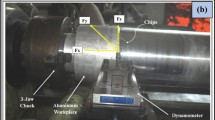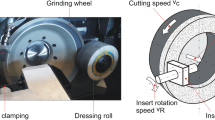Abstract
To extend the tool life of conventional uncoated grinding cemented carbide inserts (CUG inserts) in turning GH4169 nickel-based superalloy, chemical–mechanical polishing (CMP) is applied to appropriately treat the rake face of the CUG insert to address the defects including grinding burn, crack, and thermal deformation. The material removal rate (MRR) and the rake face roughness Ra of YG10 chemical–mechanical polished cemented carbide inserts (CMP inserts) corresponding to the six types of abrasives particles are investigated by applying the single factor method, and the diamond powder is the most suitable to polish YG10 inserts. Thus, CMP parameters are optimized using Taguchi method coupled with both the grey relation analysis and fuzzy inference. Furthermore, the comparison experiments of the cutting performance of the CUG insert and the CMP insert in turning GH4169 are carried out, under the same cutting condition, compared with the CUG insert, the average tool life of the CMP insert is increased by 35.92%. This study demonstrates that the CMP technique is an effective potential method to improve the surface integrity, the cutting performance and the tool life of conventional uncoated grinding cemented carbide inserts & tools in the machining of difficult-to-cut materials.












Similar content being viewed by others
References
Ezugwu, E. O., Wang, Z. M., & Macado, A. R. (1999). The machinability of nickel-based alloys: A review. Journal of Materials Processing Technology,86(1–3), 1–16. https://doi.org/10.1016/S0924-0136(98)00314-8.
Choudhury, I. A., & El-Baraide, M. A. (1998). Machinability of nickel-base super alloys: A general review. Journal of Materials Processing Technology,77, 278–284. https://doi.org/10.1016/S0924-0136(97)00429-9.
Arunachalam, R. M., & Mannan, M. A. (2000). Machinability of nickel-based high temperature alloys. Machining Science and Technology,4(1), 127–168. https://doi.org/10.1080/10940340008945703.
Ezugwu, E. O., Bonney, J., & Yamane, Y. (2003). An overview of the machinability of aeroengine alloys. Journal of Materials Processing Technology,134(2), 233–253. https://doi.org/10.1016/S0924-0136(02)01042-7.
Ulutan, D., & Ozel, T. (2011). Machining induced surface integrity in titanium and nickel alloys: A review. International Journal of Machine Tools & Manufacture,51, 250–280. https://doi.org/10.1016/j.ijmachtools.2010.11.003.
Luo, S. Y., Liu, Y. C., Chou, C. C., & Chen, J. P. (2001). Performance of power filled resin-bonded diamond wheels in the vertical dry grinding of tungsten carbide. Journal of Materials Processing Technology,118(1–3), 329–336. https://doi.org/10.1016/S0924-0136(01)00861-5.
Hegeman, J. B. J. W., Hosson, J. T. M. D., & With, G. (2001). Grinding of WC–Co hard-metals. Wear,248(1–2), 187–196. https://doi.org/10.1016/S0043-1648(00)00561-5.
Kim, J. D., & Lee, E. S. (1999). A study of the mirror-like grinding of sintered carbide with optimum in-process electrolytic dressing. The International Journal of Advanced Manufacturing Technology,15(9), 615–623. https://doi.org/10.1007/s001700050110.
Yin, L., Spowage, A. C., Ramesh, K., Huang, H., Pickering, J. P., & Vancoille, E. Y. J. (2004). Influence of microstructure on ultraprecision grinding of cemented carbides. International Journal of Machine Tools and Manufacture,44(5), 533–543. https://doi.org/10.1016/j.ijmachtools.2003.10.022.
Sharman, A. R. C., Hughes, J. I., & Ridgway, K. (2004). Workpiece surface integrity and tool life issues when turning Inconel 718TM nickel based superalloy. Machining Science and Technology,8(3), 399–414. https://doi.org/10.1081/MST-200039865.
Yang, Q., Yang, J., Wen, Y., Zhang, Q., Chen, L., & Chen, H. (2018). A novel route for the synthesis of ultrafine WC-15 wt %Co cemented carbides. Journal of Alloys and Compounds,748, 577–582. https://doi.org/10.1016/j.jallcom.2018.03.197.
Li, J., Cheng, J., Wei, B., & Chen, P. (2019). Preparation and performance of ultrafine grained WC-10Co alloys with added La2O3. Ceramics International,45(3), 3969–3976. https://doi.org/10.1016/j.ceramint.2018.11.071.
Fabijanić, T. A., Alar, Ž., & Ćorić, D. (2016). Influence of consolidation process and sintering temperature on microstructure and mechanical properties of near nano- and nano-structured WC-Co cemented carbides. International Journal of Refractory Metals and Hard Materials,54, 82–89. https://doi.org/10.1016/j.ijrmhm.2015.07.017.
Arunachalam, R. M., Mannan, M. A., & Spowage, A. C. (2004). Surface integrity when machining age hardened Inconel 718 with coated carbide cutting tools. International Journal of Machine Tools & Manufacture,44, 1481–1491. https://doi.org/10.1016/j.ijmachtools.2004.05.005.
Sharman, A. R. C., Hughes, J. I., & Ridgway, K. (2006). An analysis of the residual stresses generated in Inconel 718TM when turning. Journal of Materials Processing Technology,173(3), 359–367. https://doi.org/10.1016/j.jmatprotec.2005.12.007.
Yamaguchi, H., Srivastava, A. K., Tan, M. A., Riveros, R. E., & Hashimoto, F. (2012). Magnetic abrasive finishing of cutting tools for machining of titanium alloys. CIRP Annals- Manufacturing Technology,61, 311–314. https://doi.org/10.1016/j.cirp.2012.03.066.
Yamaguchi, H., Hendershot, P., Pavel, R., & Jonathan, C. I. (2016). Polishing of uncoated cutting tool surfaces for extended tool life in turning of Ti–6Al–4V. Journal of Manufacturing Processes,24(2), 355–360. https://doi.org/10.1016/j.jmapro.2016.06.014.
Malik, F., & Hasan, M. (1995). Manufacturability of the CMP process. Thin Solid Films,270(1–2), 612–615. https://doi.org/10.1016/0040-6090(96)80083-6.
Jang, S., Jeong, H., Yuh, M., Park, I., & Park, J. (2016). Effect of glycine on copper CMP. International Journal of Precision Engineering and Manufacturing-Green Technology,3(2), 155–159. https://doi.org/10.1007/s40684-016-0019-1.
Xu, Q., Chen, L., Fang, J., & Yang, F. (2015). A chemical mechanical planarization model for aluminum gate structures. Microelectronic Engineering,131, 58–67. https://doi.org/10.1016/j.mee.2014.09.023.
Seo, J., Kim, J. H., Lee, M., You, K., Moon, J., Lee, D. H., et al. (2017). Multi-objective optimization of tungsten CMP slurry for advanced semiconductor manufacturing using a response surface methodology. Materials and Design,117(5), 131–138. https://doi.org/10.1016/j.matdes.2016.12.066.
Lee, D., Lee, H., & Jeong, H. (2016). Slurry components in metal chemical mechanical planarization (CMP) process: A review. International Journal of Precision Engineering,17(12), 1751–1762. https://doi.org/10.1007/s12541-016-0201-y.
Ji, J., Pan, G., Zhang, W., Du, Y., He, P., Tian, Y., et al. (2017). Role of additive in alkaline slurries for Co CMP. ECS Journal of Solid State Science and Technology,6(12), 813–818. https://doi.org/10.1149/2.0111712jss.
Wang, Y., Chen, Y., Zhao, Y., & Min, P. (2017). Chemical mechanical planarization of Al alloy in alkaline slurry at low down pressure. Journal of Materials Science: Materials in Electronics,28(4), 3364–3372. https://doi.org/10.1007/s10854-016-5930-2.
Hu, Z., Qin, C., Chen, Z. C., Yang, Z., Fang, T., & Mao, M. (2018). Experimental study of chemical mechanical polishing of the final surfaces of cemented carbide inserts for effective cutting austenitic stainless steel. The International Journal of Advanced Manufacturing Technology,95, 4129–4140. https://doi.org/10.1007/s00170-017-1493-5.
Santos, A. L. B. D., Duarte, M. A. V., Abrao, A. M., & Machado, A. R. (1999). An optimisation procedure to determine the coefficients of the extended Taylor’s equation in machining. International Journal of Machine Tools and Manufacture,39(1), 17–31. https://doi.org/10.1016/S0890-6955(98)00025-X.
Acknowledgements
This work is supported by the programs of Hunan Provincial Department of Science and Technology of China (No. 2016GK2014), Hunan Provincial Department of Education of China (No. 19K094), Xiangtan Science and Technology Bureau, Hunan, China (No. CG-YB20191010), and Hunan Provincial Natural Science Foundation (2019JJ50591). which the authors greatly appreciate.
Author information
Authors and Affiliations
Corresponding author
Additional information
Publisher's Note
Springer Nature remains neutral with regard to jurisdictional claims in published maps and institutional affiliations.
Rights and permissions
About this article
Cite this article
Hu, Z., Qin, C., Chen, X. et al. Chemical–Mechanical Polishing of Cemented Carbide Insert Surface for Extended Tool Life in Turning of GH4169 Nickel-Based Superalloy. Int. J. Precis. Eng. Manuf. 21, 1421–1435 (2020). https://doi.org/10.1007/s12541-020-00347-3
Received:
Revised:
Accepted:
Published:
Issue Date:
DOI: https://doi.org/10.1007/s12541-020-00347-3




